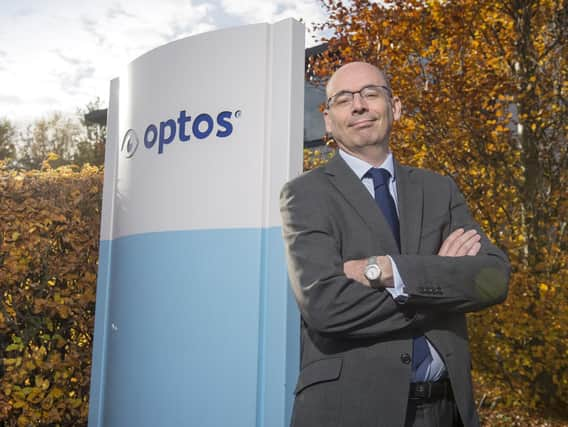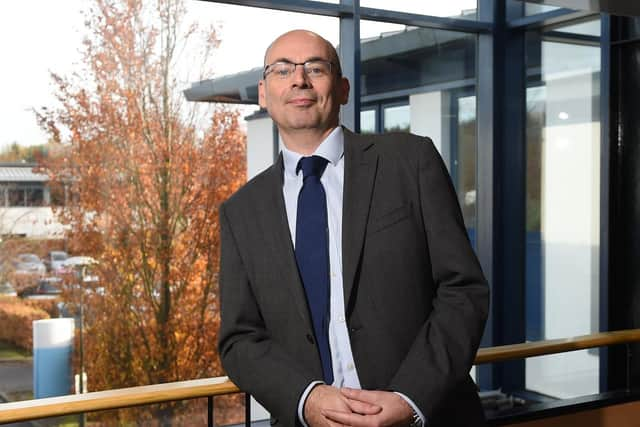The Big Interview: Optos chief executive Robert Kennedy


Chief executive Robert Kennedy shines a spotlight on the company’s work, which can save people’s sight and even their lives – citing a case where Optos technology detected a brain tumour needing urgent treatment.
He is especially proud that one of the Dunfermline-headquartered firm’s machines was put on display at the National Museum of Scotland in 2016. “It really shows the level of engineering and skills that exist here and that we continue to build on.”
Advertisement
Hide AdAdvertisement
Hide AdOptos devices are used to identify disorders and diseases whose first signs appear in the retina of the eye, such as retinal detachments and tears, glaucoma, diabetic retinopathy and age-related macular degeneration.


Kennedy notes the progress of the firm since its formation in 1992 from low-tech beginnings – evidenced by a photo on its website of the actual napkin that provided a makeshift canvas for a sketch that led to its first patent application.
The business came about after founder Douglas Anderson’s young son had gone blind in one eye after a retinal detachment was detected too late. The boy had been having regular eye exams, but routine methods were uncomfortable, especially for a child, which made a complete assessment impossible.
Patient-friendly
Anderson set out to commercialise a patient-friendly product that encompassed a digital widefield image of the retina in a single capture.
Optos now has 16,000 devices around the globe, from about 4,000 about a decade ago, most of them in optometrists’ practices.
Kennedy says turning a concept into something that worked was not an easy process – many people at the time said the vision could not be realised. Optos spent seven years on research to develop a method of image capture using lasers and mirrors to scan within the eye rather than the traditional method which was limited by the size of the pupil.
Kennedy highlights the determination of Anderson – who was later awarded an OBE – to get the business off the ground, by sending out hundreds of letters requesting funding. The business was originally financed through angel and venture capital investors – including Edinburgh-based Archangels, also formed in 1992.
Earlier this year, it was revealed that life sciences companies based in Scotland raised a record combined equity investment of £85m in the 12 months to the end of January, a 27 per cent year-on-year rise, underlining the sector’s contribution to the economy.
Advertisement
Hide AdAdvertisement
Hide AdOptos floated on the London Stock Exchange in 2006, and in 2015 was acquired by Japan’s Nikon – famous for its photography products – in a £259m deal.
Nikon had previously said it wanted to enter the medical arena to leverage its optical technologies, with medical imaging viewed as a growth market on the back of an ageing population.
Higher demand
“Like all aspects of healthcare at the moment, there’s an ever-increasing demand,” says Kennedy of eyecare, with a large share of the main eye diseases – such as glaucoma – being age-related. There has also been a jump in diabetes-related eye disease.
Kennedy has been in the chief executive seat since 2016, having joined in 2011 as the firm’s finance boss.
He has spent most of his career to date in international manufacturing groups, as well as management consultancy for what is now PwC and serving as the finance director of the University of Dundee.
He started his career at BICC – now known as Balfour Beatty – following an economics degree at the University of Sheffield. “I’ve always been interested in industry and particularly manufacturing,” he says.
As for handling the high-tech detail of his current role, he states: “One of the things I really enjoy and always have done is actually understanding the business – I think it’s really important to do that… I know enough to ask questions and understand how it works and be able to get a sense of what our customers want and how we can deliver on that.”
The firm now has about 230 staff in Dunfermline, where the main activity is product development, as well as activities that support this such as clinical, regulatory, and European sales, while its primary manufacturing base is also located in the town.
Advertisement
Hide AdAdvertisement
Hide AdThe Fife team is part of a part of a 500-strong global workforce that extends as far as Australia, Tokyo and Massachusetts.
Exports
Optos exports 98 per cent of its products – with 70 per cent of what it sells going to the US, where it made its first sale. Japan and China are its second and third largest markets respectively. “We’re looking to continue to grow into Europe as well,” says Kennedy, noting progress in France, Spain and Scandinavia in the past few years, for example.
As for his concerns over Brexit, Kennedy says: “Any uncertainty is far from ideal,” but adds, “whilst the EU’s an important market for us and will certainly continue to be, more than 85 per cent of our sales are outside Europe.
“Yes, it’s important and we’ve taken steps to reduce risk where we can like holding more inventory. Ultimately, once the path becomes a bit clearer we’ll just need to respond appropriately.
“As a business we have to manage that uncertainty – we can’t let it stop us growing and developing what we want to do.”
The present product offering includes the Daytona imaging device, which was introduced in 2012 and “really kick-started a real growth period” for Optos, according to Kennedy.
This was followed by the California in 2014, targeted at ophthalmologists, which garnered a 2019 Queen’s Award for Enterprise Innovation, having previously won in the Enterprise in International Trade category in 2001 and 2007.
Optos has also had to make room in the trophy cabinet for the likes of the European Mediscience Awards Technology of The Year prize and the Royal Academy of Engineering MacRobert Award – the latter deemed the UK’s most prestigious engineering innovation accolade.
Advertisement
Hide AdAdvertisement
Hide AdKennedy also points out that the business has been bringing in new functionality to its devices in the form of OCT – Optical Coherence Technology – which uses light waves to take cross-section pictures of the retina along the lines of a CT scan.
Unveiling
Last month, Optos debuted its latest product, Silverstone, at the American Academy of Ophthalmology in San Francisco. This combines “world-leading” ultra-widefield retinal imaging with OCT and can enhance pathology detection and disease management. Indeed, state-of-the-art eye exams are able to help detect stroke risk and even metastatic cancer.
Kennedy believes Silverstone will become Optos’ flagship device. “I think we’re the first company in the world that really offers the capability to capture these OCT scans in this way across the whole of the retina. We think that’ll be a game-changer for our customers and their patients in the same way ultra-widefield retinal imaging was [when we introduced it] 20 years ago.”
A key focus now for the Optos team is on Silverstone’s post-launch phase. “Our plan now over the next couple years or so will be to add more features on to that device,” such as software to help with diagnoses.
The business is also tapping into artificial intelligence. “If we look at the next two or three years it’s really going to be about how do we take our platforms that we’ve got now and add more tools that help support our customers?”
Optos spends about $15m (£12m) a year on research and development. Its turnover is $212m, having doubled in the last ten years. It operates in a Scottish life sciences sector that industry insiders expect to reach an annual turnover of £8 billion by 2025, making it one of the nation’s key growth areas, with 2,100 job openings by 2029.
Kennedy says: “Our vision is to continue to be the leader in eye-care imaging… we’ll look to continue to enhance our product offering, build the platform we’ve got, continue to develop into new segments like primary care and continue to expand geographically… trying to grow into areas like Latin America, the Middle East and Africa.
“I think the future ambition remains the same – just to keep taking this technology and get it to a bigger market.”
